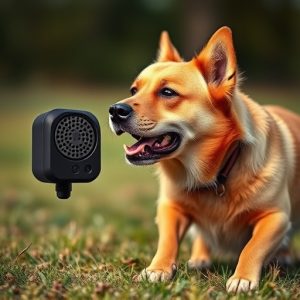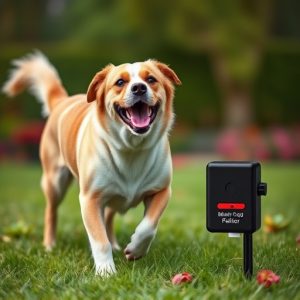Uncovering Safe Ultrasonic Dog Behavior Correction Tools: A Comprehensive Guide
Ultrasonic dog behavior correction tools, operating within the 25-64 kHz range, use inaudible sound…….
Ultrasonic dog behavior correction tools, operating within the 25-64 kHz range, use inaudible sound waves as a humane alternative to traditional punishment for unwanted pet behaviors. These devices are subject to safety regulations like the Electronic Pet Deterrent Safety Regulations to prevent harm. Responsible usage involves choosing reputable brands, following guidelines strictly, and consulting professionals for optimal settings and minimal risk. Balancing positive reinforcement with negative reinforcement techniques ensures effective training while prioritizing canine well-being.
“Unleashing a new era in pet training, the ultrasonic dog behavior correction tool has emerged as an innovative solution for pet owners. This article delves into the inner workings of these electronic pet deterrents, offering a comprehensive guide on their effectiveness and safety. We explore how they use ultrasonic waves to correct canine behavior while navigating the regulatory landscape and potential risks. By understanding the technology and adopting best practices, pet parents can make informed decisions, ensuring both the safety of their furry companions and effective training outcomes.”
- Understanding Ultrasonic Dog Behavior Correction Tools
- How Electronic Pet Deterrents Work
- Safety Considerations and Regulatory Framework
- Evaluating the Efficacy and Potential Risks
- Best Practices for Using Ultrasonic Devices Responsibly
Understanding Ultrasonic Dog Behavior Correction Tools
Ultrasonic dog behavior correction tools have gained popularity as a non-physical way to train pets. These devices emit high-frequency sound waves that are inaudible to humans but can be detected by dogs, triggering a response to stop unwanted behaviors. Understanding how these tools work is crucial when considering their effectiveness and safety. Electronic pet deterrents, like ultrasonic trainers, operate under specific safety regulations to ensure they don’t cause harm or discomfort to animals.
These devices are designed to target specific dog behaviors, such as barking or jumping, by activating only when the identified behavior occurs. The ultrasonic sound is a gentle but effective deterrent, conditioning dogs to associate certain actions with an unpleasant (but harmless) sensation. When used responsibly and according to manufacturer guidelines, ultrasonic dog behavior correction tools can be a humane alternative to traditional punishment methods, promoting positive reinforcement training techniques.
How Electronic Pet Deterrents Work
Electronic pet deterrents, like ultrasonic dog behavior correction tools, operate by emitting high-frequency sound waves that are inaudible to humans but irritating to animals. These devices are designed to disrupt unwanted behaviors, such as barking or jumping on furniture, without causing harm. The sounds typically range from 25 to 64 kHz, above the human hearing range but within the sensitive frequency range of dogs. When an animal is exposed to the sound, it perceives it as a discomfort, prompting them to alter their behavior.
The safety and effectiveness of these devices are governed by strict Electronic Pet Deterrent Safety Regulations. These regulations ensure that manufacturers adhere to guidelines for emitting levels and frequency ranges to prevent any potential harm to pets or humans. Regular testing and adherence to these standards are crucial in ensuring the well-being of both pets and their owners, making electronic deterrents a humane alternative to traditional punishment methods.
Safety Considerations and Regulatory Framework
When considering an electronic pet deterrent, such as an ultrasonic dog behavior correction tool, safety considerations are paramount. These devices emit high-frequency sound waves that are typically inaudible to humans but can deter animals through vibration. However, it’s crucial to ensure they’re used responsibly and within recommended guidelines. The lack of comprehensive global standards for electronic pet deterrents means that manufacturers often rely on self-regulation, emphasizing safe usage instructions.
Regulatory frameworks vary across regions, with some countries banning or restricting certain types of electronic pet deterrents due to potential health risks. For instance, the European Union has stringent guidelines on electromagnetic fields and noise exposure, which can impact the design and availability of such devices. Pet owners should always choose products from reputable manufacturers that conduct thorough safety testing and provide clear instructions for responsible use. Additionally, staying informed about local regulations ensures compliance and promotes ethical pet training practices.
Evaluating the Efficacy and Potential Risks
When evaluating the effectiveness of an ultrasonic dog behavior correction tool, it’s crucial to consider both its positive impacts and potential risks. These electronic pet deterrents emit high-frequency sound waves that are inaudible to humans but can prompt dogs to alter their behavior. Studies have shown that when used correctly, these tools can effectively curb unwanted behaviors like barking, jumping, or aggression by reinforcing desired behavior through negative reinforcement.
However, safety regulations and responsible use are paramount. Electronic pet deterrents must be employed ethically and within the guidelines set by relevant authorities. Improper or excessive use could potentially cause physical discomfort or even harm to pets, leading to anxiety, disorientation, or other behavioral issues. It’s essential for owners to understand their device’s limitations, follow usage instructions carefully, and consult with a veterinarian or professional trainer if needed to ensure both the tool’s safety and the well-being of their canine companion.
Best Practices for Using Ultrasonic Devices Responsibly
When using an ultrasonic dog behavior correction tool, adhering to best practices is crucial for both your pet’s safety and well-being. Firstly, ensure that the device is designed specifically for canine use and approved by veterinary professionals or behaviorists. Second, consult with a trainer or expert to understand the appropriate frequency and tone settings, as incorrect usage could cause discomfort or even harm. Regularly check the device for any signs of damage before each use, and always follow the manufacturer’s instructions regarding range and activation triggers.
Moreover, it’s essential to combine ultrasonic deterrents with positive reinforcement training. Use the device sparingly and only when necessary, such as during specific unwanted behaviors. Reward your dog with treats and praise when they exhibit desired behavior, reinforcing learning while minimizing reliance on electronic deterrents. Additionally, be mindful of Environmental factors; some dogs may react more strongly in certain settings. Regularly review and adjust training methods to ensure the device remains a safe, effective tool for modifying canine conduct without causing undue stress or anxiety.
Ultrasonic dog behavior correction tools, while offering a non-physical approach to training, have gained popularity as an alternative to traditional methods. Understanding how these devices work and adhering to safety regulations, such as those set by electronic pet deterrents safety frameworks, is crucial for responsible use. Evaluating their efficacy shows mixed results, with some dogs responding positively and others unaffected. Best practices include consistent usage, combining ultrasonic tools with positive reinforcement, and monitoring your dog’s behavior. As with any training method, patience and adaptability are key to success.


